Read Reviews
The Best Spring Lawn Feed
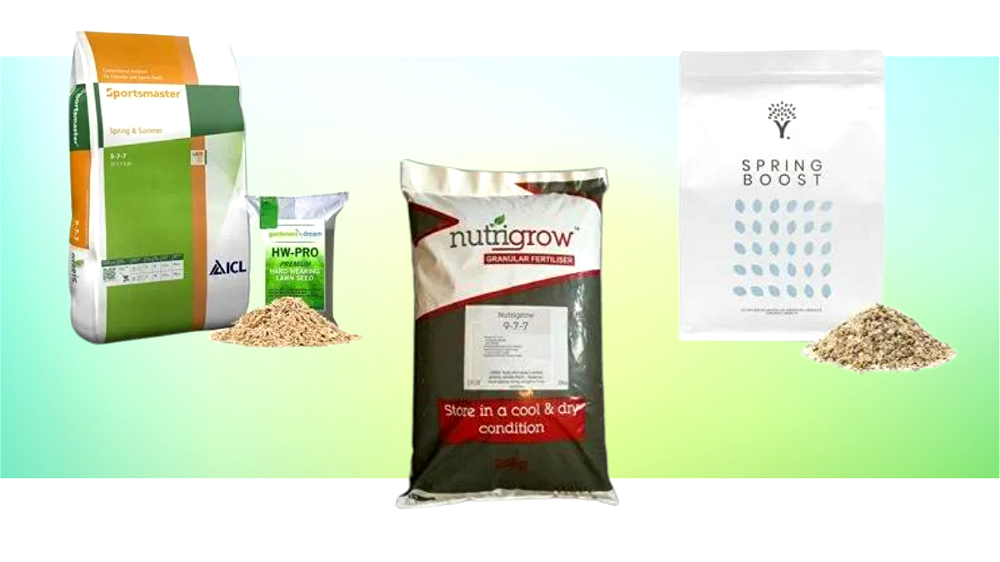
-
Sportsmaster Spring and Summer Lawn Feed
-
Moowy Spring Boost Lawn Feed
-
Nutrigrow Granular Fertiliser
-
Proctors Spring and Summer Lawn Grass Feed
-
Bridgewater Garden Supplies Professional Spring Lawn Feed
Spring Lawn Feed Reviews
- Easy to spread and good results can be achieved either using a spreader or spreading by hand
- Results can be visible in as little as a week
- Makes grass visibly greener and denser
- Does not require too much maintenance - a small amount of care can yield good results
- Rarely scorches grass
Suitable for established lawns, this Sportsmaster Spring and Summer Lawn Feed helps create a carpet of greener, denser grass. It can be used any time from the start of spring to the end of summer, breaking down quickly for great uptake of nutrients.
With a NPK ratio of 9-7-7, it’s a reasonably balanced formula, with a slightly higher nitrogen content in order to encourage growth during the growing season.
Coming in a 25 kg bag, the manufacturers (Sportsmaster) recommend spreading this fertiliser at a density of 40 g/m². It can be spread either by hand, or using a rotary/drop spreader, as long as you can ensure an even application. When used at the recommended rate, one 25 kg bag should cover an area of approximately 600 m² – more than suitable for most large lawns.
Given that only a couple of applications are required per year, one bag will last most gardeners for at least a couple of years.
There is some maintenance required after using this lawn feed as the granules need to be well watered in; however, it is relatively forgiving and doesn’t often leave scorch marks. If applied during a time when rain is expected, you won’t have to do as much manual watering either.
In some cases, improvement on the lawn can be seen within a week, and generally speaking, there is a noticeable difference in the appearance of the lawn after a couple of weeks. It’s a great way to help grass recover from the wear and tear that is more common over the spring/summer months when we’re all outside more.
There is also a 100 g sample pack of ‘Gardeners Dream Hardwearing Lawn Seed’ included. It’s only enough to cover a couple of square metres, but there’s certainly no harm in having a little freebie thrown in.
Overall, this is one of the best lawn feeds for spring because of how quickly it gets to work and how easy it is to apply. For lawns that tend to get a little tired-looking in the warmer months, it’s a great option to consider.
Did you find this review helpful?
- Achieves visible results very quickly, in as little as one week
- Improves both the thickness and colour of the lawn
- Can be used on either newly sown grass or an established lawn
- Small pack size suitable for small gardens without having too much excess product
- Resealable packet makes it easy to store the lawn feed if necessary
- Large amount of water required to properly water in the seed
Moowy Spring Boost Lawn Feed is a fast-acting fertiliser that can create a tall, thick carpet of grass in approximately four weeks – and that’s if you’re starting from zero.
In cases where a lawn is already established, benefits of using this lawn feed are often visible in 1 – 2 weeks.
It’s available in several different bag sizes, with the smallest 1.25 kg option being suitable for small/medium gardens, or repairing specific areas. It’s also a good purchase if you’re worried about wasting money, or fertiliser, and want to avoid buying a bigger bag than necessary.
Like most springtime lawn feeds, it has a higher percentage of nitrogen than other nutrients, contains 12 % nitrogen, 5% phosphorous, 5% potassium and 2% magnesium oxide. The magnesium oxide isn’t present in all fertilisers and is aimed towards improving photosynthesis (and grass green-ness).
Also, although this product is geared towards springtime use, Moowy state that it can actually be applied any time from February – November, meaning it’s a great option if you only want to buy one fertiliser to use (almost) all year round.
The granules are easy to distribute, and can be used with spreaders to make the process easier. After application, this lawn feed is relatively high maintenance – requiring a lot of water to ensure that the nutrients are absorbed into the ground as intended.
Whether you’re starting the lawn from scratch, or are looking to give existing grass a boost, this is one of the best lawn feeds for spring that will show quality results in a small amount of time.
Did you find this review helpful?
- Visible improvement to lawn after 4 - 6 weeks
- Helps grass to look a lot thicker and greener
- Large granules are easy to spread and to see where they've been used
- Can be used from March - September so can be used across several months
- Good boost for grass that is looking tired after winter
- A lot of watering required to persuade granules to dissolve
- Slower acting than fertilisers that show results in under a week
Available at a reasonable price for such a sizeable bag, this 25 kg Nutrigrow Granular Fertiliser is a good value choice for medium/large gardens.
With an NPK ratio of 9-7-7, it contains the expected nutrients for a springtime lawn feed – slightly higher quantities of nitrogen compared to phosphorous and potassium. It works reliably, achieving good results in approximately 4 – 6 weeks.
The lawn feed helps makes lawns noticeably greener, and provides a good boost once the warm weather starts coming around once more. If you find that your lawn is often looking worse for wear after winter, this is one of the best lawn feeds for spring – giving grass a well-deserved pick-me-up.
It can also be applied from as early as March, up to September, so there are a lot of opportunities for treating the lawn, even as summer starts moving towards autumn. The lawn feed stays in the soil for approximately six weeks after application.
With relatively large granules, measuring between 2 – 3 mm, the Nutrigrow Granular Fertiliser is easy to spread, but it can take a lot of watering to persuade it to dissolve. This may involve watering the lawn several times a day, or using sprinklers to encourage the nutrients to sink into the soil.
This is one of the best lawn feeds for spring if you want plenty of fertiliser at a reasonable price. Although it might not show the fastest results of all the products featured on this page, when grass does grow it is thick and deeply green.
Did you find this review helpful?
- Causes grass to grow quickly and continue to grow a lot
- Lawn looks significantly healthier within four weeks
- Fast acting - some improvements visible after just 7 days
- Contains iron, can help fight moss on lawn
- Fine granules can be a little challenging to spread easily
- Relatively high maintenance in terms of how much watering-in is needed after application
With an impressive NPK ratio, this Proctors Spring and Summer Grass Feed is designed to give grass a real kick once spring rolls round.
Whereas the majority of fertilisers featured on this list have an NPK ratio of 9-7-7, this Proctors Grass Feed contains a higher proportion of nitrogen, with a ratio of 11-5-5. It significantly increases the rate at which grass grows, and can be used to boost recently-planted grass seed as well as well-established lawns.
Along with nitrogen, phosphorous and potassium, this grass feed also contains iron (to help fight moss) and magnesium oxide.
The 20 kg bag contains ‘mini-grain’ granules and will cover an area of approximately 571 m². Due to their size, spreading these granules can be slightly more difficult than working with larger fertiliser; there may be more trial and error involved with finding the correct distribution.
Nevertheless, the results are impressive and grass grows in thick and appears a deeper shade of green. Improvements in the health of grass are often visible within one week, and customers often report seeing a marked improvement in the appearance of the lawn within four weeks.
It’s best applied just before a period of rain, as the lawn feed needs plenty of watering in.
If you’re keen for something that will get grass growing after winter, this is one of the best lawn feeds for spring on the market. With such a high ratio of nitrogen, it’s suitable for giving grass a sizeable boost once the growing season starts.
Did you find this review helpful?
- Contains sulphur which is useful for aiding plant growth but not present in all fertilisers
- Suitable for several applications only four weeks apart
- Mini-granule formula should dissolve easier into the soil than larger ones
- Can be used on both newly-establish and existing lawns
- Mini granules can be harder to spread accurately compared to larger ones
If you think your lawn is going to need several applications of fertiliser to get it back to full health after winter, the Bridgewater Garden Supplies Spring Lawn Feed is a good option to consider.
Unlike some fertilisers that remain in the soil for six weeks or more, this fast-acting lawn feed can be applied 2 – 3 times during early spring/summer, with applications as little as four weeks apart. This can help give the lawn a prolonged nutrient lift.
It has an NPK ratio of 9-7-7, much like the majority of the fertilisers featured on this page. It has a marginally higher content of nitrogen compared to phosphorous and nitrogen. However, unlike the other lawn feeds, it also contains 13% sulphur.
Sulphur is quickly becoming viewed as a one of the principal nutrients for aiding plant health, so it could be an invaluable addition depending on the existing composition of your soil.
This mini-granule fertiliser can be used on newly-established lawns, or older lawns that are looking a little tired. Applied from March to June, it can help aid new growth, or refresh existing grass.
On new lawns, Bridgewater Garden Supplies recommend applying this fertiliser at a rate of 70 g/m², and 30 g/m² on existing lawns.
It’s one of the best lawn feeds for spring if you’re looking for a product that contains sulphur, and it’s useful for tired lawns due to the number of applications that can be done over a relatively short period of time.
Did you find this review helpful?
How to Choose The Best Lawn Feed for Spring
After winter, it’s not unusual for lawns to look a little worse for wear.
Fortunately, spring is the best time of year to put some work into lawn maintenance; grass is in its ‘growing phase’ and even a small boost of fertiliser can make a big difference.
Generally speaking, fertilisers that are aimed at spring/summer use have a high nitrogen content in order to encourage this growth further.
There are several other things to look out for, when choosing the best lawn feed for spring, and the following information will help you make a well-informed decision.
READ NEXT: Monthly Lawn Care Guide
Finding the Best NPK Ratio
Let’s start by discussing NPK ratios. If you’ve looked at different fertilisers, you’ll likely have seen the letters NPK followed by three numbers.
If you’re already familiar with NPK, you’ll know how important it is to choose a fertiliser with the best NPK balance for your lawn. If you’re new to NPK ratios, you’re in the right place. Here we’ll look at all the basics that you’ll need to know.
The letters in NPK represent three elements. N = ‘nitrogen’, P = ‘phosphorous’ and K = ‘potassium’. These nutrients are found in the majority of fertilisers because they are vital to the different stages of plant growth. However, different fertilisers contain different ratios of each nutrient.
Depending on the condition of your lawn, the type of soil you have and the season, certain nutrient ratios will be more beneficial than others.
Firstly, it’s important to understand how this information is conveyed. On the bag/box of fertiliser, you will see the something that looks like this: NPK 9-7-7. In this particular case, this fertiliser would be made up of 9 parts nitrogen to 7 parts phosphorous and 7 parts potassium (this would be considered a good ratio for a springtime fertiliser).
Here are more details about these three important nutrients. Understanding each nutrient’s purpose will help you choose the best fertiliser, with the most suitable NPK ratio, for your garden.
Nitrogen
Nitrogen is essential to all stages of plant growth. It helps plants convert energy from the sun into food and can encourage growth spurts. Grass with plenty of nitrogen will often grow quickly.
Nitrogen helps plants create chlorophyll which, amongst other things, is responsible for making plants green colour. As a result, not only does nitrogen help with growth, it can also encourage grass to grow greener and healthier.
As mentioned, the best lawn feeds for spring will have a reasonably high nitrogen content – you would expect a high ratio of nitrogen to phosphorous/potassium. This is to take advantage of the grass’ potential to grow in springtime.
Phosphorous
Phosphorous is important for maintaining the general health of a plant, from its roots to its leaves. Naturally, an unhealthy plant will grow slowly, so phosphorous is vital for maintaining a thick lawn.
One of the ways phosphorous helps plants is by improving the strength of the root system and stem.
Much like nitrogen, phosphorous also helps plants convert the sun’s energy into food and energy.
In some gardens, the soil lacks phosphorous. This will result in grass that grows poorly. If there isn’t enough phosphorous, grass will have a weak root system and won’t be prepared to withstand poor conditions (e.g., summer drought or harsh winters).
Nevertheless, it’s also important to know that too much phosphorous can also be a problem. Phosphorous builds up in soil and if there is too much of it, it can stop plant’s from being able to extract other necessary nutrients from the ground.
Potassium
Potassium aids photosynthesis. It can also help plants to use and store water efficiently. One of the benefits of this is that it makes them less vulnerable during dry seasons (like summer!).
Potassium also encourages plants to grow a strong root system, which is useful for all-round health.
The Best NPK Ratio for Spring Lawn Feed
Nitrogen is a crucial nutrient in spring lawn feed, and you want it to be present in higher amounts than phosphorous and potassium.
An NPK ratio of 9-7-7 is pretty standard, and will be effective at encouraging grass to grow. Grass will grow upwards and achieve denser coverage. It will also develop a better root system.
If you’re more interested in visible, fast results for summer, you could choose a lawn feed with an even higher ratio of nitrogen, like 11-5-5.
Applying Granules or Liquid Fertiliser
Fertilisers come as either solid granules, or a liquid.
As a liquid, fertiliser might be 1) a concentrate that needs to be added to water, or 2) ready to apply straight away. Liquid fertiliser tend to get to work quickly, and it’s pretty easy to apply using a watering can.
If the fertiliser comes as a concentrate that needs to be diluted, it can be a little more time consuming and inconvenient.
Liquid fertilisers need to be used when there isn’t much rain scheduled. Otherwise, they can get washed away before they’ve even benefitted the soil.
Granular fertilisers, on the other hand, are applied dry and watered into the soil after spreading.
Using a fertiliser spreader is the best way to get good results with a granular fertiliser. Although granules can be spread by hand, it’s often hard to get the distribution rate correct.
Granular fertilisers sit on the soil and can take a long time to dissolve. They generally release nutrients slowly, over a period of weeks. It’s important not to let them sit on the lawn dry, as they may scorch the grass. They either need to be watered daily, or spread when rain is forecast.
READ NEXT: The UK’s Best Garden Spreaders
Spring Lawn Feed FAQs
Generally speaking, the best time to spread spring lawn feed is from February – April. This will capitalise on the grass’ growing season, and get grass looking good in time for summer.
If you miss this period, most spring feeds can still be applied through the summer as well (as long as any granules are extremely well watered in to avoid scorching); however, results may not be quite as good.
You’ll get good results with either. Sometimes, granular lawn feed can require more maintenance – if there’s not enough rain, you’ll have to make sure you’re continuously watering the granules so that they don’t get dry and scorch the grass.
This isn’t as much of a problem with liquid lawn feed, especially if it is diluted well in the first place. However, liquid lawn feed requires a period of dry weather after application, to give it time to work. If you think it’s going to rain, go with granular lawn feed.
One of the main reasons that iron is included in lawn feed is that it helps to kill off moss. If your lawn is struggling to grow because there’s a lot of moss in it, you might find that a lawn feed with iron will help clear some of the moss away. Be warned – moss will turn black as it dies. If you have large patches of moss on your lawn, it may look a lot worse before it starts to look better.
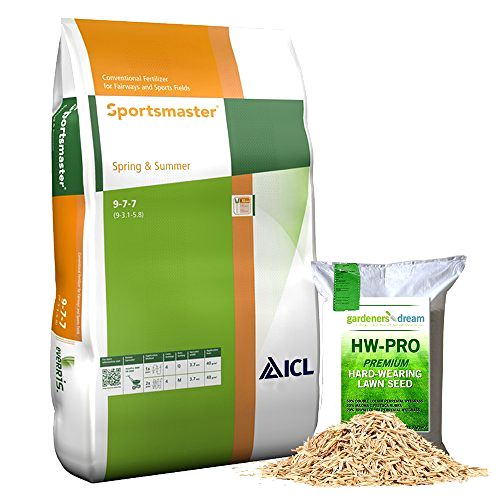
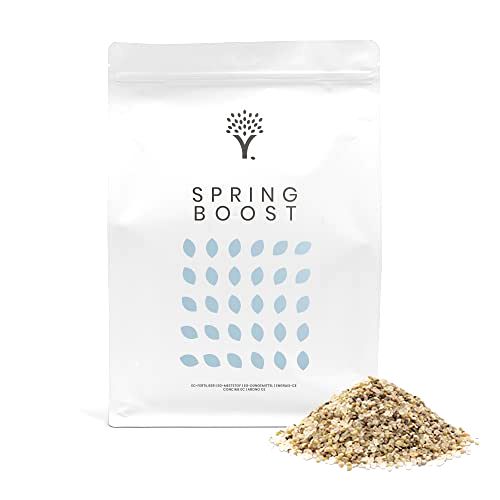

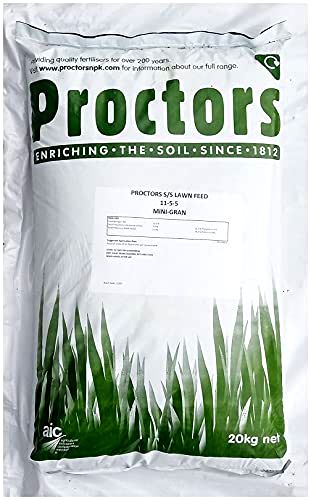
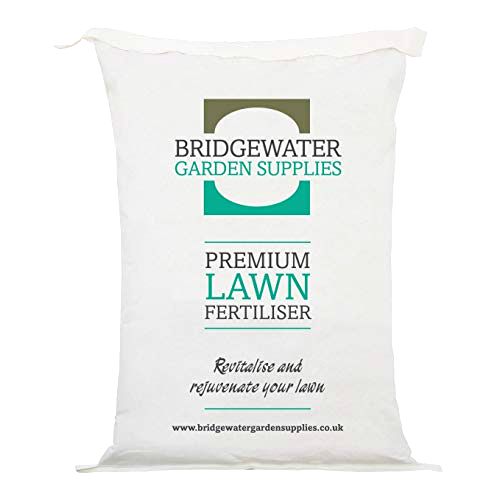

Share